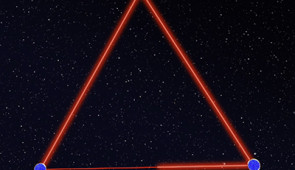
Shane L. Larson
Research Professor of Physics and Astronomy
Associate Director, Center for Interdisciplinary Exploration and Research in Astrophysics (CIERA)
Northwestern astrophysicist is member of international team working on new detector
EVANSTON, Ill. --- Gravitational waves — ripples in the fabric of space-time first predicted by Albert Einstein in 1916 — have been directly detected here on Earth since September 2015. Now an international team of scientists that includes a Northwestern University astrophysicist has been cleared to build a new detector, this time in space.
Today (Jan. 25) the European Space Agency (ESA) voted to formally adopt the Laser Interferometer Space Antenna (LISA) as its next large mission, putting the space-based gravitational-wave observatory on track for construction and launch in 10 years.
LISA’s discoveries will complement scientists’ knowledge about the beginning, evolution and structure of the universe. The detector will be sensitive to gravitational waves of a lower frequency than those detected by Earth-bound observatories, such as the Laser Interferometer Gravitational-Wave Observatory (LIGO).
"This is a huge milestone for LISA,” said Northwestern’s Shane Larson, a U.S. board member on the LISA Consortium (the large collaboration of scientists who work on LISA) and co-chair of the consortium’s Astrophysics Working Group. “The mission has been designed and planned, and new technology has been built and tested. Today it's official that we’re moving forward to construction and launch. This will be the first gravitational-wave observatory in space. It will be the only one of its kind, likely for decades, and will transform the landscape of astronomy."
Larson is a research professor of physics and astronomy and associate director of Northwestern’s Center for Interdisciplinary Exploration and Research in Astrophysics (CIERA). He is interested in learning how gravitational waves can be used to understand aspects of the universe that light cannot reveal. Larson’s Northwestern research group simulates the Milky Way’s population of dead binary stars, called white dwarfs, which will be one of the main observational sources for LISA.
Larson also is a member of the NASA LISA team. He was part of the international team that first detected gravitational waves, a historic discovery announced Feb. 11, 2016.
“The gravitational waves that LISA observes will be in a different part of the spectrum than those LIGO observes,” Larson said. “LISA will enable us to study completely different astrophysics than other gravitational-wave observatories.”
Gravitational waves are caused by the rapid motion of compact massive objects, such as neutron stars and black holes. LISA will be most sensitive to large-scale events such as massive black holes colliding in the centers of galaxies and smaller binary systems of dead stars made up of white dwarfs, neutron stars or black holes. LISA will detect gravitational radiation in the yet unexplored window between 0.1 mHz and 1 Hz, waves that cannot be detected by ground-based detectors. Unique to LISA will be the detection of gravitational waves from stellar black holes swirling around massive ones in galactic nuclei.
The LISA instrument will consist of three spacecraft in a triangular configuration with 2.5-million-kilometer arms, moving in an Earth-like orbit around the sun. Gravitational waves from sources throughout the universe will produce slight oscillations in the arm lengths (smaller than the diameter of an atom). LISA will capture these motions and measure the gravitational waves by using laser links to monitor the displacements of test masses free-falling inside the spacecraft.
The LISA satellites and their scientific payload are being built by ESA, ESA member nations and NASA.



Research Professor of Physics and Astronomy
Associate Director, Center for Interdisciplinary Exploration and Research in Astrophysics (CIERA)